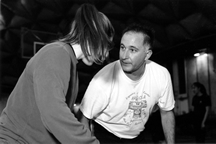
Two individuals sway around each other in the middle of the room. One reaches out with his foot to trip the other, only to fall, caught off-balance because he has been cleverly dodged.But the would-be tripper is unfazed, and hurls himself into a backwards, fluid cartwheel. Observers who surround them play a role as well, as they sing, smile and laugh at the contenders.
This is capoeira (pronouncedka-poo-AIR-ah), a Brazilian art that fuses dance, sport and martial arts to produce a pantomime of fighting. It is both a personal and scholarly passion of Greg Downey, assistant professor of anthropology. A student of capoeira for 13 years, he teaches it twice a week to faculty, staff and students. His experience as a practitioner is at the heart of his bookLearning Capoeira:Lessons in Cunning From an Afro-Brazilian Art,released this month by Oxford University Press.
Capoeira developed in 19 th century Brazil from the practices of African slaves who merged rural dance formsinfluenced by religion, rhythms and social dancesand an urban-combatchallenge dancingthat used razor blades and sticks. Urban gangs comprised of freed or escaped slaves, people of mixed race and Portuguese sailors embraced the art. By the late 1880s, when the Brazilian monarchy fell, capoeira was declared illegal by the leaders of the new republic. One could be arrested just for knowing how to do it.
The art survived and began to flourish againin the 1930s, when a capoeirista calledmestreorteacherBimba challenged anyone to come toSalvador,Brazil, and beat him. Boxers and wrestlers answered the call, but Mestre Bimbas nickname became Three Blows because he usually needed no more to win.He later opened a school, and ended up attracting elite members of society to the art.
As a writer and an anthropologist,Downeyis making the point that a complex, socially intricate practice such as capoeira exemplifies human culture and anthropology.Culture does not stop at the skin, nor does it reside solely in the mind.Taking seriously how different ways of standing, moving, and acting animate us, informs our perceptions, and enlivens our sense of ourselves.
As a teacher,Downeyhopes to instill that how one performs within the roda (song circle) has implications for how one lives outside the circle.Training a person to play capoeira, ideally, transforms the students visceral sense of self and the way he or she sees the world,Downeynotes.
Capoeira teaches how to stay calm and fluid, how to react gracefully and with humor.As an urban art, it teaches practitioners how to remain relaxed, yet always alert to what is happening around them.
TopicID: 10685